Swarms of tourists are drawn to Comino’s Blue Lagoon each year, allured by countless photos of a bay with the clearest of turquoise waters, white sands and open spaces.
Once they get there, however, these visitors find a totally different reality: an inlet filled with boats and ships of all shapes and sizes, blaring music, deckchairs and umbrellas covering every bit of flat ground and thousands of people walking around chaotically and bumping into each other.
The Blue Lagoon is very different to what people see in Instagram and Facebook photos. The area remains beautiful, yes, but the experience is dampened by the sheer number of people that visit on a daily basis – an estimated 8,000 to 10,000.
Besides spoiling the fun for everyone, overcrowding is also having a negative impact on the ecologically sensitive island.
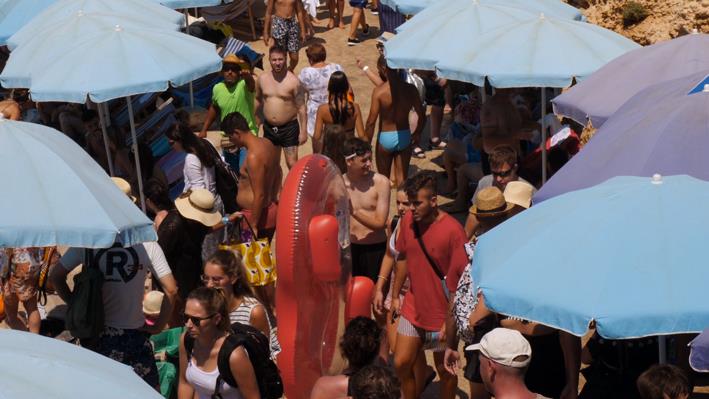
A team from The Malta Independent on Sunday visited Comino on Tuesday – during its busiest time of the year. Not that the Santa Marija holidays make much of a difference, because most of the visitors are foreigners. Many Maltese have long realised what the situation is, and mostly keep away from the area.
Our team arrived at around 10am, which is a full hour and a half before most tourists boats come in. The situation at that time was still bearable, although one is not welcomed in the best of ways on the island. After passengers disembark from the vessel, they have to walk through a heavily crowded area, covered from end to end by deckchairs and umbrellas. Then, you walk up a short but steep hill, to be greeted by tacky kiosks selling anything from beverages served in hollowed-out pineapples, to hotdogs and burgers, goggles, snorkels and beach towels.
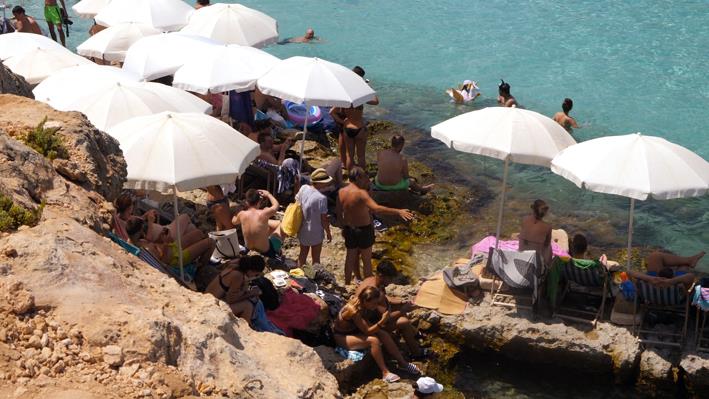
The Blue Lagoon is Comino’s most popular area, and most visitors don’t stray afar. The problem is that there is not much space next to the water’s edge, and the few areas where people can spread their beach towels on are massively overcrowded.
By 11.30am, the situation had changed drastically. Several ships came into the bay, some of them carrying upwards of 700 people. As soon as they docked alongside the makeshift concrete jetty, a steady flow of people gushed out over the rear ramps until the vessels were empty.
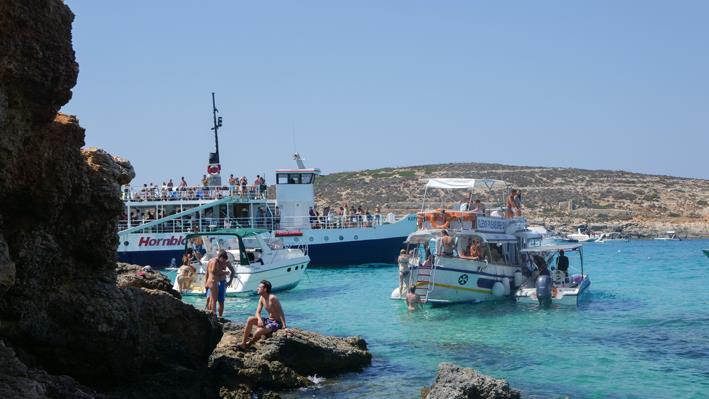
The already overcrowded strips of beach became more overcrowded, and tourists could be heard complaining that there was no space for them to sit or swim. A small sandy beach near the jetty was so overcrowded that bathers were practically standing shoulder to shoulder in the murky water.
Many decided that this was not their idea of fun, so they searched for quieter sunbathing spots on the garigue slopes above the bay. At least the kiosk owners were happy, with a never-ending stream of customers coming their way.

On the water, the speedboat rides were now in full swing, with the roaring sound of powerful engines and blaring pop music filling the area.
Tourists who spoke to this newspaper said they were surprised by what they found – the pictures they had seen while planning their Malta holiday showed a much more peaceful place.
Some said they had read about the overcrowding problem, so this was not surprising to them, but they still felt that there were too many people about.
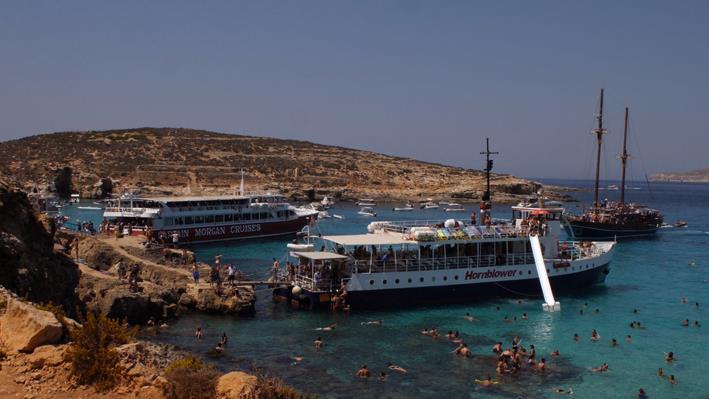
While going round the area soon after we arrived (before the main tourist influx began), our team had already observed the littering that takes place on Comino; from plastic bottles, to crisps packets and those awful pineapples floating around. All the rubbish that we photographed was then chucked into garbage bins.
But the situation got even worse as the day went by.
To be fair, there are several litter bins around, and officials from the Malta Tourism Authority were handing out disposable ashtrays. But where there are people, there is bound to be littering.
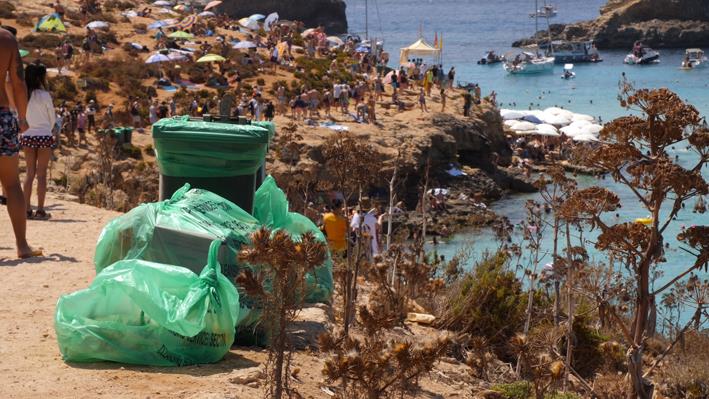
Over the years, environmental NGOs have suggested that the number of visitors should be capped. Private operators, they say, should have a quota and only be allowed to carry a set number of passengers per day. Other countries, like Italy, Iceland and Ecuador have imposed limits on the number of people that can visit ecologically sensitive sites. In Malta, this is still a dream.
The need for a tourism carrying capacity assessment of the Blue Lagoon is highlighted in the Natura 2000 Management Plan for Comino.
“Other operational objectives seek to address threats to habitats and species including the need to prepare and implement a tourism carrying capacity assessment of the Blue Lagoon and provide recommendations for management, including assessing seasonal variability of the number of tourists, landings of tourists by ferries, entrance fee options, zoning and wardens.”

No such study has been published to date, and NGOs fear that overcrowding on Comino will only get worse when a new ferry service is launched. The Malta Independent revealed, some weeks back, that Transport Malta (TM) has issued a Request for Proposals for a public ferry service between Ċirkewwa and Comino.
TM had said that the new service would not replace private operators, but would complement them. The service would be operated on year-round basis and berthing facilities would be upgraded, the agency had said. This, however, will not tackle the issue of overcrowding. In fact, making it easier and cheaper for people to visit the Blue Lagoon might actually make things worse.
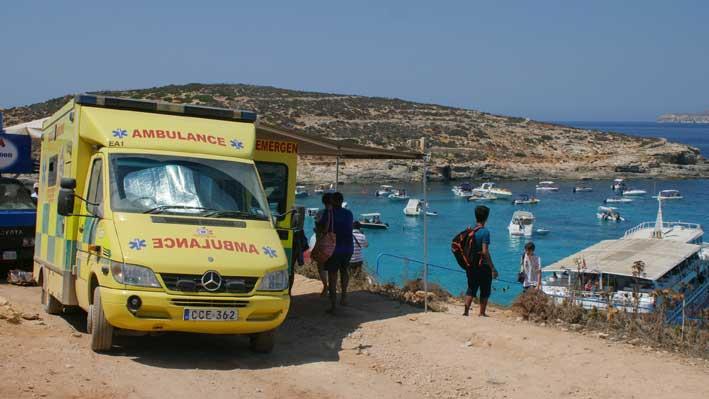
Overcrowding an extra headache for lifeguards
Lifeguards from the Emergency Response and Rescue Corps (ERRC), a voluntary NGO, watch over the Blue Lagoon all summer long. One of the lifeguards, Adrian Bonnici, told this newsroom that the overcrowding made their job harder.
“Currently, we have six people permanently stationed here between 9am and 6pm. This year we also have a hydro-ambulance covering Comino and the south of Gozo.”
While the ERRC has a strong presence at the lagoon, an increase in the number of visitors would require a larger team of lifeguards, he said.
“Overcrowding increases the risk of accidents. It also makes it more difficult to control the masses, especially to get people out of the way if something happens. We also have people swimming outside the designated swimming zones, where vessels operate, so the overcrowding makes it more difficult for us to monitor and manage the area,” Bonnici said.
Photos: Alenka Falzon